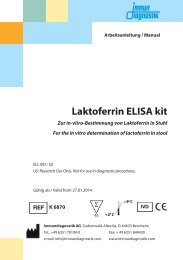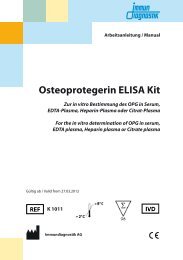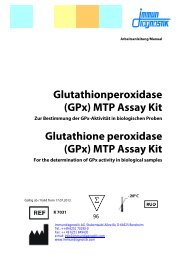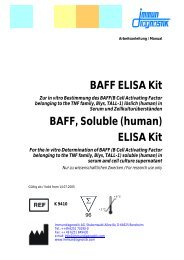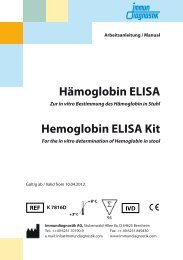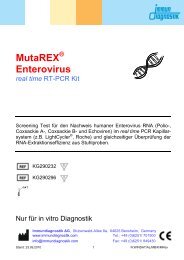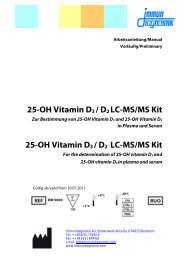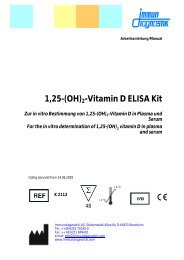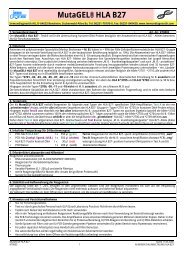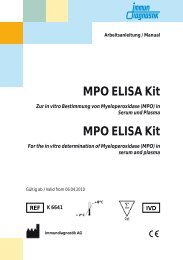Arbeitsanleitung/Manual Zonulin - bei Immundiagnostik
Arbeitsanleitung/Manual Zonulin - bei Immundiagnostik
Arbeitsanleitung/Manual Zonulin - bei Immundiagnostik
You also want an ePaper? Increase the reach of your titles
YUMPU automatically turns print PDFs into web optimized ePapers that Google loves.
96<br />
+2 °C<br />
<strong>Ar<strong>bei</strong>tsanleitung</strong>/<strong>Manual</strong><br />
<strong>Zonulin</strong> ELISA Kit<br />
Zur in vitro Bestimmung von <strong>Zonulin</strong> in Serum, EDTA-Plasma und<br />
Stuhl<br />
For the in vitro determination of <strong>Zonulin</strong> in serum, EDTA-plasma<br />
and stool<br />
Gültig ab / Valid from 06.04.2010<br />
K 5600<br />
Nur für Forschungszwecke / For research use only<br />
+8 °C<br />
<strong>Immundiagnostik</strong> AG, Stubenwald-Allee 8a, D 64625 Bensheim<br />
Tel.: ++49 6251 70190-0<br />
Fax: ++ 49 6251 849430<br />
e.mail: Info@immundiagnostik.com<br />
www.<strong>Immundiagnostik</strong>.com
<strong>Ar<strong>bei</strong>tsanleitung</strong>/<strong>Manual</strong> <strong>Zonulin</strong><br />
Inhaltsverzeichnis Seite/Page<br />
Table of content 2<br />
1. VERWENDUNGSZWECK 3<br />
2. EINLEITUNG 3<br />
3. TESTPRINZIP 4<br />
4. INHALT DER TESTPACKUNG 4<br />
5. ERFORDERLICHE LABORGERÄTE UND HILFSMITTEL 5<br />
6. VORBEREITUNG UND LAGERUNG DER REAGENZIEN 5<br />
7. HINWEISE UND VORSICHTSMASSNAHMEN 6<br />
8. PROBENVORBEREITUNG 7<br />
9. TESTDURCHFÜHRUNG 9<br />
HINWEISE 9<br />
PIPETTIERSCHEMA 10<br />
10. ERGEBNISSE 11<br />
MUSTEREICHKURVE 11<br />
11. EINSCHRÄNKUNGEN 12<br />
12. QUALITÄTSKONTROLLE 12<br />
ERWARTETE ERGEBNISSE 12<br />
13. LITERATUR 13<br />
14. ALLGEMEINE HINWEISE ZUM TEST 14<br />
1
<strong>Ar<strong>bei</strong>tsanleitung</strong>/<strong>Manual</strong> <strong>Zonulin</strong><br />
1. INTENDED USE 16<br />
2. SUMMARY AND EXPLANATION OF THE TEST 16<br />
3. PRINCIPLE OF THE TEST 16<br />
4. MATERIAL SUPPLIED 17<br />
5. MATERIAL REQUIRED BUT NOT SUPPLIED 17<br />
6. PREPARATION AND STORAGE OF REAGENTS 18<br />
7. PRECAUTIONS 19<br />
8. SPECIMEN COLLECTION AND PREPARATION 19<br />
9. ASSAY PROCEDURE 19<br />
PROCEDURAL NOTES 21<br />
TEST PROCEDURE 22<br />
10. RESULTS 23<br />
TYPICAL CALIBRATION CURVE 23<br />
11. LIMITATIONS 24<br />
12. QUALITY CONTROL 24<br />
EXPECTED VALUES 24<br />
12. REFERENCES 25<br />
14. GENERAL NOTES ON THE TEST AND TEST PROCEDURE 26<br />
2
<strong>Ar<strong>bei</strong>tsanleitung</strong>/<strong>Manual</strong> <strong>Zonulin</strong><br />
1. VERWENDUNGSZWECK<br />
Der hier beschriebene Assay ist für die Bestimmung von <strong>Zonulin</strong> in Serum,<br />
EDTA-Plasma und Suhl geeignet. Nur für Forschungszwecke.<br />
2. EINLEITUNG<br />
<strong>Zonulin</strong> ist ein humanes Protein ähnlich dem Zonula-occludens-Toxin von<br />
Vibrio cholerae, das an der Regulation der interzellulären Kontakte (Tight<br />
junctions) in der Darmwand beteiligt ist. <strong>Zonulin</strong> bindet an einen<br />
spezifischen Rezeptor an der Oberfläche der Epithelzellen der Darmbarriere<br />
und aktiviert eine Kaskade biochemischer Ereignisse, welche die Öffnung<br />
der Tight junctions induzieren und als Folge die Durchlässigkeit der Darmepithelzellen<br />
erhöhen, so dass verschiedene Substanzen die Darmbarriere<br />
passieren und Autoimmunreaktionen auslösen können.<br />
Die Ar<strong>bei</strong>tsgruppe um Fasano hat festgestellt, dass <strong>bei</strong> Zöliakie- und Typ 1<br />
Diabetes-mellitus-Patienten das <strong>Zonulin</strong>-<strong>Zonulin</strong>rezeptor-System stärker<br />
aktiviert ist. Patienten mit aktiver Zöliakie zeigen erhöhte Konzentrationen<br />
von <strong>Zonulin</strong> und <strong>Zonulin</strong>-Antikörpern im Vergleich zu nicht-Zöliakiepatienten<br />
und Patienten in Remission unter glutenfreier Diät.<br />
Im Hinblick auf den autoimmunbedingten Typ 1 Diabetes konnte in<br />
Versuchen mit Ratten gezeigt werden, dass der Anstieg der <strong>Zonulin</strong>-Spiegel<br />
und die erhöhte Durchlässigkeit der Darmwand einer Typ 1 Diabeteserkrankung<br />
zeitlich vorausgehen. Umgekehrt konnte im Tierexperiment ein<br />
Typ 1 Diabetes verhindert werden, wenn das Protein <strong>Zonulin</strong> blockiert<br />
wurde.<br />
Darüber hinaus wurde berichtet, dass viele Zöliakiepatienten auch an<br />
anderen Autoimmunkrankheiten leiden. Es wird vermutet, dass <strong>bei</strong> der<br />
Entwicklung von Zöliakie und anderen Autoimmunerkrankungen wie<br />
insulinabhängiger Diabetes, Multiple Sklerose und Rheumatoide Arthritis,<br />
erhöhte <strong>Zonulin</strong>-Spiegel einen entscheidenden Faktor darstellen.<br />
3
<strong>Ar<strong>bei</strong>tsanleitung</strong>/<strong>Manual</strong> <strong>Zonulin</strong><br />
3. TESTPRINZIP<br />
Dieser <strong>Zonulin</strong> Enzymimmunoassay dient zur quantitativen Erfassung von<br />
<strong>Zonulin</strong> aus humanem Serum, EDTA-Plasma oder Stuhl.<br />
Das Testprinzip beruht auf einer Kompetitionsreaktion zwischen dem freien<br />
Antigen der Probe und dem immobilisierten Antigen auf der Mikrotiterplatte.<br />
Standards bzw. Proben werden mit dem Primärantikörper gegen<br />
<strong>Zonulin</strong> direkt auf die vorbeschichtete Mikrotiterplatte überführt.<br />
Das Antigen aus den Proben konkurriert mit dem auf der Mikrotiterplatte<br />
immobilisierten Antigen um die freien Bindungsstellen der spezifischen<br />
anti-<strong>Zonulin</strong> Antikörper.<br />
Die Detektion erfolgt über einen Peroxidase-markierten Sekundärantikörper<br />
und die entsprechende Substratumsetzung. Die Quantifizierung erfolgt<br />
durch Bestimmung der Absorption <strong>bei</strong> 450 nm.<br />
4. INHALT DER TESTPACKUNG<br />
Art. Nr. Abkürzung Kit Komponenten Menge<br />
K 5600MTP MTP Mikrotitermodul, vorbeschichtet 12 x 8<br />
Vertiefungen<br />
K 5600WP WASHBUF BM- Waschpufferkonzentrat 10x 100 ml<br />
K 5600EP EXBUF Extraktionspuffer 25 ml<br />
K 5600PV SAMPLEBUF Stuhlverdünnungspuffer 2.5x 100 ml<br />
K 5600KV CONJBUF Konjugatverdünnungspuffer 15 ml<br />
K 5600AK AB <strong>Zonulin</strong>-Antikörper 200 µl<br />
K 5600VP ABBUF <strong>Zonulin</strong>-Antikörperverdünnungspuffer 15 ml<br />
K 5600K CONJ Konjugat 200 µl<br />
K 5600ST STD Standards (lyophilisiert) 2 x 7 vials<br />
K 5600KO1 CTRL Kontrolle (lyophilisiert) 2 x 1 vial<br />
K 5600KO2 CTRL Kontrolle (lyophilisiert) 2 x 1 vial<br />
K 5600TMB SUB TMB Substrat (Tetramethylbenzidin),<br />
gebrauchsfertig<br />
4<br />
15 ml<br />
K 5600AC STOP ELISA Stopplösung, gebrauchsfertig 15 ml
<strong>Ar<strong>bei</strong>tsanleitung</strong>/<strong>Manual</strong> <strong>Zonulin</strong><br />
5. ERFORDERLICHE LABORGERÄTE UND HILFSMITTEL<br />
• Bidestilliertes Wasser (aqua bidest.)<br />
• Präzisionspipetten und Pipettenspitzen für den Einmalgebrauch mit<br />
variablen Volumina von 5 - 1000 µl<br />
• Folie zum Abkleben der Mikrotiterplatte<br />
• Mikrotiterplattenschüttler<br />
• Multikanal- bzw. Multipipette<br />
• Eppendorf-Gefäße 1,5 ml<br />
• 15 ml Röhrchen (z.B. Falcon)<br />
• Vortex-Mixer<br />
• Laborübliche Glas- oder Plastikröhrchen (Einmalartikel)<br />
• Mikrotiterplattenphotometer mit Filter 450 oder 405 nm<br />
(Referenzfilter 620 oder 690 nm)<br />
6. VORBEREITUNG UND LAGERUNG DER REAGENZIEN<br />
• Bitte achten Sie <strong>bei</strong> mehrfachem Einsatz der Platte darauf, dass die<br />
Reagenzien, wie in der Vorschrift beschrieben, gelagert und nur die für<br />
den jeweiligen Ansatz benötigten Reagenzienmengen frisch<br />
•<br />
angesetzt werden. Der Kit kann so bis zu 4x je nach Probenaufkommen<br />
bis zum angegebenen Haltbarkeitsdatum verwendet werden.<br />
Reagenzien mit einem Volumen kleiner 100 µl sollten vor Gebrauch<br />
zentrifugiert werden, um Volumenverluste zu vermeiden.<br />
• Der WASHBUF (BM-Waschpufferkonzentrat) wird vor Gebrauch 1:10 in<br />
bidestilliertem Wasser (aqua bidest.) verdünnt (100 ml WASHBUF + 900 ml<br />
aqua bidest.), gut mischen. Aufgrund der hohen Salzkonzentration in den<br />
Stammlösungen kann es zu Kristallbildungen kommen. Die Kristalle lösen<br />
sich im Wasserbad <strong>bei</strong> 37 °C auf. Der WASHBUF kann <strong>bei</strong> 2-8°C bis zum<br />
angegebenen Haltbarkeitsdatum aufbewahrt werden. Die verdünnte<br />
Pufferlösung ist <strong>bei</strong> 2-8 °C einen Monat in einem geschlossenen Gefäß<br />
haltbar.<br />
• Der SAMPLEBUF (Stuhlverdünnungspufferkonzentrat) muss vor<br />
Gebrauch 1:2.5 mit aqua bidest. verdünnt werden (100 ml SAMPLEBUF +<br />
150 ml aqua bidest), gut mischen. Das Pufferkonzentrat kann <strong>bei</strong> 2-8°C<br />
bis zum angegebenen Haltbarkeitsdatum aufbewahrt werden. Die<br />
verdünnte Pufferlösung ist 1 Monat in einem geschlossenen Gefäß <strong>bei</strong><br />
2-8 °C haltbar.<br />
5
<strong>Ar<strong>bei</strong>tsanleitung</strong>/<strong>Manual</strong> <strong>Zonulin</strong><br />
• Die lyophilisierten STD (Standards) und CTRL (Kontrollen) werden mit<br />
500 µl bidestilliertem Wasser (aqua bidest.) rekonstituiert und zum Lösen<br />
10 Minuten stehen gelassen. Rekonstituierte Standards und Kontrollen<br />
können 1 Monat <strong>bei</strong> -20°C gelagert werden. Wiederholtes Einfrieren<br />
und Auftauen ist zu vermeiden.<br />
• Der AB (<strong>Zonulin</strong>-Antikörper) wird 1:100 in ABBUF (<strong>Zonulin</strong>-Antikörperverdünnungspuffer)<br />
verdünnt (50 µl AB + 4,95 ml ABBUF). Unverdünnter<br />
AB ist <strong>bei</strong> 2–8 °C bis zum angegebenen Haltbarkeitsdatum stabil.<br />
Verdünnter AB ist nicht stabil und kann nicht aufbewahrt werden.<br />
• Das CONJ (Konjugat) wird 1:100 in CONJBUF (Konjugatverdünnungspuffer)<br />
verdünnt (50 µl 2.AB + 4,95 ml CONJBUF). Unverdünntes CONJ<br />
(Konjugat) ist <strong>bei</strong> 2–8 °C bis zum angegebenen Haltbarkeitsdatum stabil.<br />
Verdünntes Konjugat ist nicht stabil und kann nicht aufbewahrt<br />
werden.<br />
• Alle anderen Testreagenzien sind <strong>bei</strong> 2-8 °C zu lagern und <strong>bei</strong><br />
entsprechender Lagerung bis zum angegebenen Verfallsdatum (siehe<br />
Etikett) verwendbar.<br />
7. HINWEISE UND VORSICHTSMASSNAHMEN<br />
• Das für Kitkomponenten verwendete humane Material wurde auf HIV,<br />
Hepatitis B und Hepatitis C getestet und für negativ befunden. Dennoch<br />
wird empfohlen, die Kitkomponenten als Vorsichtsmaßnahme immer wie<br />
potentiell infektiöses Material zu behandeln.<br />
• Die Kitkomponenten enthalten zum Schutz vor bakteriellen<br />
Kontaminationen Natriumazid oder Thimerosal. Natriumazid bzw.<br />
•<br />
Thimerosal sind giftig. Auch Substrate für enzymatische Farbreaktionen<br />
sind als giftig und karzinogen beschrieben. Jeder Kontakt mit Haut oder<br />
Schleimhaut ist zu vermeiden.<br />
Die Stopplösung besteht aus verdünnter Schwefelsäure (H2SO4). H2SO4 ist<br />
eine starke Säure und muss auch in verdünnter Form mit Vorsicht<br />
verwendet werden. H2SO4 verursacht <strong>bei</strong> Kontakt mit der Haut<br />
Verätzungen. Es sollte daher mit Schutzhandschuhen, Schutzkleidung und<br />
Schutzbrille gear<strong>bei</strong>tet werden. Bei Kontakt mit der Schwefelsäure muss<br />
die verätzte Stelle sofort mit viel Wasser gespült werden.<br />
• Die Reagenzien dürfen nach Ablauf des Mindesthaltbarkeitsdatums nicht<br />
mehr verwendet werden.<br />
6
<strong>Ar<strong>bei</strong>tsanleitung</strong>/<strong>Manual</strong> <strong>Zonulin</strong><br />
8. PROBENVORBEREITUNG<br />
EDTA-Plasma und Serum<br />
Das Probenmaterial bis zur Verwendung <strong>bei</strong> –20 °C lagern.<br />
250 µl frische EDTA–Plasma- oder Serumproben in Eppendorf-Gefäße<br />
pipettieren, mit 250 µl EXBUF (Extraktionspuffer) versetzen, gut vortexen<br />
und für 20 Minuten <strong>bei</strong> 13000 rpm zentrifugieren. Danach wird der<br />
Überstand abgenommen, in ein Eppendorfröhrchen überführt und ein<br />
weiteres Mal für 10 Minuten <strong>bei</strong> 13000 rpm zentrifugiert. 50 µl des<br />
Überstandes werden pro Vertiefung in den Test eingesetzt.<br />
Verdünnungsfaktor 1:2<br />
Stuhl<br />
Stuhlprobenextraktion<br />
Wir empfehlen folgende Probenvorbereitung:<br />
1. Es wird ein Stuhlaufar<strong>bei</strong>tungssystem (z. B. Probenvorbereitungssystem<br />
der Fa. Roche Diagnostics/Mannheim (Best. Nr. 745 804)) verwendet, das<br />
100 mg Stuhlprobe dosiert. In diesem Stuhlaufar<strong>bei</strong>tungssystem wird<br />
die Stuhlprobe in 5 ml Stuhlverdünnungspuffer suspendiert.<br />
Puffervolumen konstant: 5 ml<br />
Verdünnungsfaktor konstant: 1:50<br />
2. Alternativ kann eine Stuhlprobenmasse im Bereich von 80 - 120 mg<br />
manuell eingewogen werden. Bitte die exakte Menge für jede Probe<br />
notieren!<br />
a. Jede einzelne Probe wird in 5 ml Puffer unabhängig von der<br />
eingewogenen Menge suspendiert.<br />
Puffervolumen konstant: 5 ml<br />
Der Verdünnungsfaktor ändert sich entsprechend der Einwaage. Er<br />
kann der folgenden Tabelle entnommen werden und muss <strong>bei</strong> der<br />
Auswertung berücksichtigt werden:<br />
7
<strong>Ar<strong>bei</strong>tsanleitung</strong>/<strong>Manual</strong> <strong>Zonulin</strong><br />
Einwaage<br />
[mg]<br />
Verdünnungs-<br />
faktor<br />
80 62.5<br />
82 60.9<br />
84 59.5<br />
86 58.1<br />
88 56.8<br />
90 55.6<br />
92 54.3<br />
94 53.2<br />
96 52.1<br />
98 51.0<br />
100 50<br />
b. Die Puffermengen für die einzelnen Proben variieren in Abhängigkeit<br />
von den Stuhleinwaagen (siehe Tabelle). Da<strong>bei</strong> bleibt der Verdünnungsfaktor<br />
konstant.<br />
Puffervolumen variabel<br />
Verdünnungsfaktor konstant: 1:50<br />
Somit kann der Verdünnungsfaktor für die Auswertung aller Proben<br />
einheitlich verwendet werden.<br />
Einwaage<br />
[mg]<br />
Puffervolumen<br />
[ml]<br />
80 4.0<br />
82 4.1<br />
84 4.2<br />
86 4.3<br />
88 4.4<br />
90 4.5<br />
92 4.6<br />
94 4.7<br />
96 4.8<br />
98 4.9<br />
100 5.0<br />
8<br />
Einwaage<br />
[mg]<br />
Verdünnungs-<br />
faktor<br />
102 49.0<br />
104 48.1<br />
106 47.2<br />
108 46.3<br />
110 45.5<br />
112 44.6<br />
114 43.9<br />
116 43.1<br />
118 42.4<br />
120 41.6<br />
Einwaage<br />
[mg]<br />
Puffervolumen<br />
[ml]<br />
102 5.1<br />
104 5.2<br />
106 5.3<br />
108 5.4<br />
110 5.5<br />
112 5.6<br />
114 5.7<br />
116 5.8<br />
118 5.9<br />
120 6.0
<strong>Ar<strong>bei</strong>tsanleitung</strong>/<strong>Manual</strong> <strong>Zonulin</strong><br />
Anschließend wird die Stuhlprobe mit dem Puffer gut gemischt (z. B.<br />
Vortexer für mindestens 30 sec. je nach Stuhlkonsistenz).<br />
Danach wird ca. 1 ml der Suspension in ein verschließbares Einweggefäß (z.<br />
B. von Eppendorf) überführt und für 5 Minuten <strong>bei</strong> 13000 g zentrifugiert.<br />
50 µl des Überstands werden pro Vertiefung im Test eingesetzt.<br />
9. TESTDURCHFÜHRUNG<br />
Hinweise<br />
• Reagenzien der Kitpackung dürfen nicht mit anderen Chargen<br />
gemischt werden.<br />
• Substratlösung muss vor Gebrauch farblos sein.<br />
• Mikrotiterstreifen während den Inkubationen mit Folie abdecken.<br />
• Schaumbildung <strong>bei</strong>m Mischen der Reagenzien vermeiden.<br />
• Die Bestimmung ist immer nach der im Kit <strong>bei</strong>gefügten <strong>Ar<strong>bei</strong>tsanleitung</strong><br />
durchzuführen.<br />
9
<strong>Ar<strong>bei</strong>tsanleitung</strong>/<strong>Manual</strong> <strong>Zonulin</strong><br />
Pipettierschema<br />
Die vorbeschichtete Mikrotiterplatte vor Gebrauch 5x mit je 250 µl<br />
verdünntem Waschpuffer waschen. Mikrotiterplatte nach dem letzten<br />
Waschgang auf Saugpapier ausschlagen.<br />
Die Bestimmungen in der Mikrotiterplatte in Doppelwerten durchführen.<br />
1. 50 µl STD (Standards), CTRL (Kontrollen) oder Proben in Doppelbestimmungen<br />
in die Vertiefungen pipettieren<br />
2. 50 µl AB (anti-<strong>Zonulin</strong>antikörper) pro Vertiefung pipettieren<br />
3. Streifen abdecken und 1,5 Stunden <strong>bei</strong> Raumtemperatur (18-26°C) im<br />
Dunkeln unter Schütteln inkubieren<br />
4. Inhalt der Platte verwerfen und 5 x mit je 250 µl verdünntem<br />
Waschpuffer waschen. Mikrotiterplatte nach dem letzten Waschgang<br />
auf Saugpapier ausschlagen<br />
5. 100 µl CONJ (Konjugat) pro Vertiefung pipettieren<br />
6. Streifen abdecken und 1,5 Stunden <strong>bei</strong> Raumtemperatur (18-26°C) im<br />
Dunkeln unter Schütteln inkubieren<br />
7. Inhalt der Platte verwerfen und 5 x mit je 250 µl verdünntem<br />
Waschpuffer waschen. Mikrotiterplatte nach dem letzten Waschgang<br />
auf Saugpapier ausschlagen<br />
8. 100 µl SUB (Substrat) pro Vertiefung pipettieren<br />
9. 5-10 Minuten <strong>bei</strong> Raumtemperatur (18-26°C) inkubieren<br />
10. 50 µl STOP (Stopplösung) pro Vertiefung zusetzen und im<br />
Mikrotiterplattenphotometer im Schüttelmodus kurz mischen<br />
11. Extinktion sofort im Mikrotiterplattenphotometer <strong>bei</strong> 450 nm gegen<br />
die Referenzwellenlänge 620 nm (oder 690 nm) messen. Sollte die<br />
Extinktion des höchsten Standards den Messbereich des Photometers<br />
übersteigen, sofort <strong>bei</strong> 405 nm gegen 620 nm (690 nm) messen<br />
10
<strong>Ar<strong>bei</strong>tsanleitung</strong>/<strong>Manual</strong> <strong>Zonulin</strong><br />
10. ERGEBNISSE<br />
Zur Auswertung des Testes empfehlen wir die 4-Parameter-Funktion.<br />
Alternativ kann auch eine Punkt-zu-Punkt-Auswertung oder eine<br />
gewichtete Spline-Funktion gewählt werden. Vor jeder automatischen<br />
Auswertung sollte stets eine Kontrolle der Doppelwerte auf Plausibilität<br />
(„Ausreißerkontrolle“) durchgeführt werden; falls dies nicht durch das<br />
verwendete Programm erfolgt, sollte diese der Operator durchführen.<br />
Standardkurve<br />
Die Abbildung ist ein Beispiel für eine Standardkurve. Die Daten dürfen<br />
nicht zur Auswertung von Kundenergebnissen verwendet werden.<br />
11
<strong>Ar<strong>bei</strong>tsanleitung</strong>/<strong>Manual</strong> <strong>Zonulin</strong><br />
11. EINSCHRÄNKUNGEN<br />
Proben mit hohen <strong>Zonulin</strong> Konzentrationen, die außerhalb des Messbereichs<br />
liegen, sollen mit EXBUF (Extraktionspuffer; EDTA-Pasma und<br />
Serum) oder Stuhlverdünnungspuffer (Stuhl) verdünnt und nochmals<br />
bestimmt werden.<br />
12. QUALITÄTSKONTROLLE<br />
Wir empfehlen Kontrollen <strong>bei</strong> jedem Testansatz mitzumessen. Die<br />
Ergebnisse der Kontrollen müssen auf Richtigkeit überprüft werden. Liegen<br />
eine oder mehrere Werte außerhalb des angegebenen Bereiches, kann<br />
<strong>Immundiagnostik</strong> AG die Richtigkeit der Werte nicht gewährleisten.<br />
Erwartete Ergebnisse<br />
EDTA-Plasma und Serum<br />
Die ermittelten Werte werden mit Verdünnungsfaktor 2 multipliziert um<br />
die tatsächliche <strong>Zonulin</strong>-Konzentration der Proben zu bestimmen.<br />
Stuhlproben<br />
Die ermittelte <strong>Zonulin</strong>-Konzentration der Stuhlprobe wird auf Grund der<br />
Probenvorbereitung wie im folgendem Beispiel berechnet:<br />
Probenvorbereitung 1 und 2b: Verdünnungsfaktor konstant: 1:50<br />
Probenvorbereitung 2a: Verdünnungsfaktor ist variabel<br />
Der entsprechende Verdünnungsfaktor jeder Probe wird der Tabelle<br />
entnommen.<br />
Normbereich<br />
Wir empfehlen jedem Labor eigenen Normwertbereich zu etablieren.<br />
12
<strong>Ar<strong>bei</strong>tsanleitung</strong>/<strong>Manual</strong> <strong>Zonulin</strong><br />
13. LITERATUR<br />
1. Wang W, Uzzau S, Goldblum SE, Fasano A. Human zonulin, a potential<br />
modulator of intestinal tight junctions. J Cell Sci 2000;113 Pt 24: 4435-40.<br />
2. Fasano A. Intestinal zonulin: open sesame! Gut 2001; 49: 159-62.<br />
3. Fasano A, Not T, Wang W et al. <strong>Zonulin</strong>, a newly discovered modulator of<br />
intestinal permeability, and its expression in celiac disease. Lancet 2000;<br />
355(9214): 1518-19.<br />
4. Thomas KE, Sapone A, Fasano A, Vogel SN. Gliadin stimulation of murine<br />
macrophage inflammatory gene expression and intestinal permeability<br />
are MyD88-dependent: role of the innate immune response in Celiac<br />
disease. J Immunol 2006; 176: 2512-21.<br />
5. Freemark M, Lynne LL. Screening for Celiac Disease in Children with Type<br />
1 Diabetes. Diabetes Care 2003; 26: 1932-39.<br />
6. Lazzarotto F, Basso D, Plebani M et al. Celiac Disease and Type 1<br />
Diabetes. Diabetes Care 2003; 26: 248-49.<br />
7. Watts T, Berti I, Sapone A et al. Role of the intestinal tight junction<br />
modulator zonulin in the pathogenesis of type 1 diabetes in BB<br />
diabeticprone rats. Proc Nat Acad Sci USA 2005; 102(8): 2916-21.<br />
8. Sapone A, de Magistris L, Pietzak M, Clemente MG, Tripathi A, Cucca F,<br />
Lampis R, Kryszak D, Carteni M, Generoso M, Iafusco D, Prisco F, Laghi F,<br />
Riegler G, Carratu R, Counts D, Fasano A. <strong>Zonulin</strong> upregulation is<br />
associated with increased gut permeability in subjects with type 1<br />
diabetes and their relatives. Diabetes 2006; 55: 1443-9.<br />
9. De Magistris MT. Zonula occludens toxin as a new promising adjuvant for<br />
mucosal vaccines. Vaccine 2006;24 Suppl 2: S2-60-1.<br />
13
<strong>Ar<strong>bei</strong>tsanleitung</strong>/<strong>Manual</strong> <strong>Zonulin</strong><br />
14. ALLGEMEINE HINWEISE ZUM TEST<br />
• Alle im Kit enthaltenen Reagenzien dürfen ausschließlich für<br />
•<br />
Forschungszwecke verwendet werden.<br />
Für die Qualitätskontrolle sind die für medizinische Laboratorien<br />
erstellten Richtlinien zu beachten.<br />
• Die charakteristischen Testdaten wie Inkubationszeiten, Inkubationstemperaturen<br />
und Pipettiervolumina der verschiedenen Komponenten<br />
wurden firmenintern festgelegt. Nicht mit dem Hersteller<br />
•<br />
abgesprochene Veränderungen in der Testdurchführung können die<br />
Resultate beeinflussen. Die Firma <strong>Immundiagnostik</strong> AG übernimmt für<br />
die hierdurch entstandenen Schäden und Folgeschäden keine Haftung.<br />
Bei Gewährleistungsansprüchen ist das beanstandete Material mit<br />
schriftlicher Erklärung innerhalb von 14 Tagen zum Hersteller - der<br />
<strong>Immundiagnostik</strong> AG zurück zu senden.<br />
14
<strong>Ar<strong>bei</strong>tsanleitung</strong>/<strong>Manual</strong> <strong>Zonulin</strong><br />
96<br />
+2 °C<br />
15<br />
+8 °C<br />
<strong>Manual</strong><br />
<strong>Zonulin</strong> ELISA Kit<br />
For the in vitro determination of <strong>Zonulin</strong> in serum, EDTA-plasma<br />
and stool<br />
Valid from 06.04.2010<br />
K 5600<br />
For research use only
<strong>Ar<strong>bei</strong>tsanleitung</strong>/<strong>Manual</strong> <strong>Zonulin</strong><br />
1. INTENDED USE<br />
The <strong>Immundiagnostik</strong> Assay is intended for the quantitative determination<br />
of zonulin in serum, EDTA-plasma and stool. For research use only.<br />
2. SUMMARY AND EXPLANATION OF THE TEST<br />
<strong>Zonulin</strong> is a novel human protein analogue to the Vibrio cholerae derived<br />
Zonula occludens toxin, which participates in tight junctions between cells<br />
of the wall of the digestive tract. <strong>Zonulin</strong> binds to a specific receptor on the<br />
surface of intestinal epithelia and triggers a cascade of biochemical events<br />
which induces tight junction disassembly and a subsequent permeability<br />
increase of the intestinal epithelia, allowing some substances to pass<br />
through and activate immune reactions.<br />
Dr. Fasano and his co-workers found out that the zonulin-zonulin-receptorsystem<br />
is more activated in celiac disease and type 1 diabetes mellitus<br />
patients. Patients with active celiac disease showed higher levels of zonulin<br />
and anti-zonulin antibodies compared to non-celiac patients and patients in<br />
remission, who were eating a gluten-free diet.<br />
Concerning the autoimmune type 1 diabetes, in experiments with rats<br />
could be demonstrated, that elevated zonulin levels as well as increased<br />
intestinal permeability precede a type 1 diabetes disease. Conversely, type 1<br />
diabetes could be prevented by inhibition of zonulin in animal experiments.<br />
In addition, it was reported that many people who suffer from celiac disease<br />
also suffer from other autoimmune disorders. It is suggested that increased<br />
levels of zonulin are a contributing factor to the development of celiac<br />
disease and other autoimmune disorders such as insulin dependent<br />
diabetes, multiple sclerosis, and rheumatoid arthritis<br />
3. PRINCIPLE OF THE TEST<br />
This enzyme immuno assay can be used for the quantitative determination<br />
of <strong>Zonulin</strong> in serum, EDTA-plasma or stool.<br />
The test principle is based on a competition between the free antigen in the<br />
samples or standards and the antigen coated on the wells of the microplate.<br />
Standards, samples and the primary anti-zonulin antibody are transferred<br />
directly into the precoated microplate wells. The antigen in the samples<br />
competes with the antigen immobilized on the wells of the microplate for<br />
the binding sites of the specific anti-zonulin antibody. A peroxidaseconjugated<br />
antibody is used for detection, and tetramethylbenzidine (TMB)<br />
as a peroxidase substrate. The enzymatic reaction is terminated by acidic<br />
stop solution. The quantification is based on the optical density at 450 nm.<br />
16
<strong>Ar<strong>bei</strong>tsanleitung</strong>/<strong>Manual</strong> <strong>Zonulin</strong><br />
4. MATERIAL SUPPLIED<br />
Cat. No Label Kit Components Quantity<br />
K 5600MTP MTP Microtiter plate, precoated 12 x 8 wells<br />
K 5600WP WASHBUF BM-wash buffer concentrate 10 x 100 ml<br />
K 5600EP EXBUF Extraction buffer 25 ml<br />
K 5600PV SAMPLEBUF Stool dilution buffer 2.5x 100 ml<br />
K 5600KV CONJBUF Conjugate dilution buffer 15 ml<br />
K 5600AK AB <strong>Zonulin</strong>-antibody 200 µl<br />
K 5600VP ABBUF <strong>Zonulin</strong>-antibody dilution buffer 15 ml<br />
K 5600K CONJ Conjugate 200 µl<br />
K 5600ST STD Standards (lyophilized) 2 x 7 vials<br />
K 5600KO1 CTRL Control (lyophilized) 2 x 1 vial<br />
K 5600KO2 CTRL Control (lyophilized) 2 x 1 vial<br />
K 5600TMB SUB TMB substrate (Tetramethylbenzidine) 15 ml<br />
K 5600AC STOP ELISA stop solution, ready to use 15 ml<br />
5. MATERIAL REQUIRED BUT NOT SUPPLIED<br />
• Bidistilled water (aqua bidest.)<br />
• Precision pipettors calibrated and tips to deliver 5-1000 µl<br />
• Foil to cover the microtiter plate<br />
• Horizontal microtiter plate shaker<br />
• A multi-channel dispenser or repeating dispenser<br />
• Centrifuge capable of 3000 x g<br />
• Eppendorf-cups, 1,5 ml<br />
• 15 ml tubes (e. g. Falcon)<br />
• Vortex-Mixer<br />
• Standard laboratory glass or plastic vials, cups, etc.<br />
• Microtiter plate reader at 450 or 405 nm<br />
(reference wave length 620 or 690 nm)<br />
17
<strong>Ar<strong>bei</strong>tsanleitung</strong>/<strong>Manual</strong> <strong>Zonulin</strong><br />
6. PREPARATION AND STORAGE OF REAGENTS<br />
• To run assay more than once ensure that reagents are stored at<br />
conditions stated on the label. Prepare only the appropriate amount<br />
necessary for each assay. The kit can be used up to 4 times within the<br />
expiry date stated on the label.<br />
• Reagents with a volume less than 100 µl should be centrifuged before<br />
use to avoid loss of volume.<br />
• The WASHBUF (BM wash buffer concentrate) should be diluted with<br />
aqua bidest. 1:10 before use (100 ml WASHBUF + 900 ml aqua bidest.),<br />
mix well. Crystals could occur due to high salt concentration in the<br />
stock solutions. The crystals must be redissolved at 37°C in a water bath<br />
before dilution of the buffer solutions. The WASHBUF is stable at 2-8°C<br />
until the expiry date stated on the label. Diluted buffer solution can<br />
be stored in a closed flask at 2-8°C for one month.<br />
• The SAMPLEBUF (stool dilution buffer concentrate) must be diluted<br />
with aqua bidist. 1:2.5 before use (100 ml SAMPLEBUF + 150 ml aqua<br />
bidist.), mix well. The buffer concentrate is stable at 2-8°C until the<br />
expiry date stated on the label. Diluted buffer solution can be stored<br />
in a closed flask at 2-8°C for one month.<br />
• The lyophilized STD (standards) and CTRL (controls) must be<br />
reconstituted with 500 µl aqua bidest. Allow the vial content to<br />
dissolve for 10 minutes and mix thoroughly by gentle inversion to<br />
insure complete reconstitution. Reconstituted standards and<br />
controls can be stored at -20°C for one month. Avoid repeated<br />
freeze-thaw cycles.<br />
• The AB (<strong>Zonulin</strong>-antibody) must be diluted 1:100 in ABBUF (<strong>Zonulin</strong>-<br />
<strong>Zonulin</strong>-antibody dilution buffer) (50 µl AB + 4.95 ml ABBUF). The AB<br />
(<strong>Zonulin</strong>-antibody) is stable at 2 -8 °C until expiry date given on the<br />
label. Diluted AB is not stable and can not be stored.<br />
• The CONJ (Conjugate) must be diluted 1:100 in CONJBUF (Conjugate<br />
dilution buffer) (50 µl CONJ + 4.95 ml CONJBUF). The CONJ (Conjugate)<br />
is stable at 2 -8 °C until expiry date given on the label. Diluted CONJ is<br />
not stable and can not be stored.<br />
• All other test reagents are ready to use. Test reagents are stable until<br />
the expiry date (see label of test package) when stored at 2-8°C.<br />
18
<strong>Ar<strong>bei</strong>tsanleitung</strong>/<strong>Manual</strong> <strong>Zonulin</strong><br />
7. PRECAUTIONS<br />
• Human materials used in kit components were tested and found to be<br />
negative for HIV, Hepatitis B and Hepatitis C. However, for safety reasons,<br />
all kit components should be treated as potentially infectious.<br />
• Kit reagents contain sodium azide or thimerosal as bactericides. Sodium<br />
azide and thimerosal are toxic. Substrates for the enzymatic color<br />
reactions are toxic and carcinogenic. Avoid contact with skin or mucous<br />
membranes.<br />
• Stop solution is composed of sulfuric acid, which is a strong acid. Even<br />
diluted, it still must be handled with care. It can cause acid burns and<br />
should be handled with gloves, eye protection, and appropriate<br />
protective clothing. Any spills should be wiped out immediately with<br />
copious quantities of water.<br />
• Reagents should not be used beyond the expiration date shown on the<br />
kit label.<br />
8. SPECIMEN COLLECTION AND PREPARATION<br />
EDTA-Plasma and Serum<br />
Store samples until use at -20 °C.<br />
Pipette 250 µl freshly collected EDTA-plasma or serum samples in<br />
Eppendorf-cups, add 250 µl EXBUF (extraction buffer), vortex well and<br />
centrifuge for 20 min at 13000 rpm. Transfer the supernatant into an<br />
Eppendorf tube and centrifuge for 10 minutes at 13000 rpm. For analysis,<br />
pipet 50 µl of the obtained supernatant per well.<br />
Dilution factor 1:2<br />
Stool samples<br />
Extraction of the stool sample<br />
We recommend the following sample preparation:<br />
1. We recommend the use of a stool sample preparation kit for dosing<br />
100 mg of stool sample (e.g. Sample preparation kit from Roche<br />
Diagnostics, Mannheim, Germany; cat # 745804). The stool sample<br />
must be suspended in 5 ml stool dilution buffer.<br />
19
<strong>Ar<strong>bei</strong>tsanleitung</strong>/<strong>Manual</strong> <strong>Zonulin</strong><br />
Constant buffer volume: 5 ml<br />
Constant dilution factor: 1:50<br />
2. Alternatively, stool samples can be manually weighted within the<br />
range of 80 – 120 mg. Please note the exact sample amount!<br />
a. Add 5 ml buffer to the stool sample not depending on the sample<br />
amount.<br />
Constant buffer volume: 5 ml<br />
The dilution factor varies depending on the sample amount which<br />
has to be considered in the subsequent calculations. Please have a<br />
look at the table for the correction factors below:<br />
Weight<br />
[mg]<br />
Dilution<br />
factor<br />
80 62.5<br />
82 60.9<br />
84 59.5<br />
86 58.1<br />
88 56.8<br />
90 55.6<br />
92 54.3<br />
94 53.2<br />
96 52.1<br />
98 51.0<br />
100 50<br />
b. The buffer volume for the individual samples varies depending on the<br />
sample amount (see table). The dilution factor remains constant.<br />
Variable buffer volume<br />
Constant dilution factor: 1:50<br />
Therefore, the same dilution factor can be used for all samples in the<br />
subsequent evaluation of the results .<br />
20<br />
Weight<br />
[mg]<br />
Dilution<br />
factor<br />
102 49.0<br />
104 48.1<br />
106 47.2<br />
108 46.3<br />
110 45.5<br />
112 44.6<br />
114 43.9<br />
116 43.1<br />
118 42.4<br />
120 41.6
<strong>Ar<strong>bei</strong>tsanleitung</strong>/<strong>Manual</strong> <strong>Zonulin</strong><br />
Weight<br />
[mg]<br />
Afterwards, mix stool sample and buffer and vortex for at least 30 sec.<br />
depending on the stool consistency.<br />
Transfer ca. 1 ml stool suspension to an Eppendorf-tube and centrifuge for 5<br />
minutes at 13000 g.<br />
For analysis, pipette 50 µl of the supernatant per well.<br />
9. ASSAY PROCEDURE<br />
Buffer Volume<br />
[ml]<br />
80 4.0<br />
82 4.1<br />
84 4.2<br />
86 4.3<br />
88 4.4<br />
90 4.5<br />
92 4.6<br />
94 4.7<br />
96 4.8<br />
98 4.9<br />
100 5.0<br />
Procedural notes<br />
• Do not interchange different lot numbers of any kit component within<br />
the same assay.<br />
• Substrate solution should remain colorless until use.<br />
• To ensure accurate results, proper adhesion of plate sealers during<br />
incubation steps is necessary.<br />
• Avoid foaming when mixing reagents.<br />
• The assay should always be performed according the enclosed manual.<br />
21<br />
Weight<br />
[mg]<br />
Buffer Volume<br />
[ml]<br />
102 5.1<br />
104 5.2<br />
106 5.3<br />
108 5.4<br />
110 5.5<br />
112 5.6<br />
114 5.7<br />
116 5.8<br />
118 5.9<br />
120 6.0
<strong>Ar<strong>bei</strong>tsanleitung</strong>/<strong>Manual</strong> <strong>Zonulin</strong><br />
Test procedure<br />
Wash the precoated microtiter plate 5 x with 250 µl of diluted wash buffer.<br />
After the final washing step, the inverted microtiter plate should be firmly<br />
tapped on absorbent paper to remove excess solution. Run the test in<br />
duplicate.<br />
1. Add 50 µl of STD (standards), CTRL (controls) or samples into each<br />
well in duplicate<br />
2. Add 50 µl of AB (anti-zonulin antibody) into each well<br />
3. Cover the strips and incubate for 1,5 hours shaking on a horizontal<br />
mixer in the dark at room temperature (18-26°C)<br />
4. Aspirate the contents of each well. Wash the microtiter plate 5 x with<br />
250 µl of diluted wash buffer. After the final washing step, the inverted<br />
microtiter plate should be firmly tapped on absorbent paper to remove<br />
excess solution<br />
5. Add 100 µl of CONJ (conjugate) into each well<br />
6. Cover the strips and incubate for 1,5 hours shaking on a horizontal<br />
mixer in the dark at room temperature (18-26°C)<br />
7. Aspirate the contents of each well. Wash the microtiter plate 5 x with<br />
250 µl of diluted wash buffer. After the final washing step, the inverted<br />
microtiter plate should be firmly tapped on absorbent paper to remove<br />
excess solution<br />
8. Add 100 µl of SUB (substrate solution) into each well<br />
9. Incubate for 5-10 minutes at room temperature (18-26°C)<br />
10. Add 50 µl of STOP (stop solution) into each well and mix shortly in the<br />
ELISA reader using the shake option<br />
11. Determine absorption immediately with an ELISA reader at 450 nm<br />
against 620 nm (alternatively at 690 nm) as a reference. If no reference<br />
wavelength is available, read only at 450 nm. If the extinction of the<br />
highest standard exceeds the range of the photometer, absorption<br />
must be measured immediately at 405 nm against 620 nm as a<br />
reference<br />
22
<strong>Ar<strong>bei</strong>tsanleitung</strong>/<strong>Manual</strong> <strong>Zonulin</strong><br />
10. RESULTS<br />
A calibration curve is constructed from the calibrators. Commercially<br />
available software can be used as well as graph paper. Results of the<br />
samples are read from this calibration curve.<br />
THE CALIBRATION CURVE IS NOT LINEAR, therefore a spline- or 4PL<br />
algorithm is recommended.<br />
Typical calibration curve<br />
The calibration curve is for demonstration only. The data cannot be used<br />
for the evaluation of test results.<br />
23
<strong>Ar<strong>bei</strong>tsanleitung</strong>/<strong>Manual</strong> <strong>Zonulin</strong><br />
11. LIMITATIONS<br />
If the absorption of any sample is outside the measurement range, the<br />
sample should be diluted with EXBUF (extraction buffer; EDTA-plasma and<br />
serum) or stool dilution buffer (stool) and re-assayed.<br />
12. QUALITY CONTROL<br />
Control samples should be analyzed with each run. Results, generated<br />
from the analysis of control samples, should be evaluated for acceptability<br />
using appropriate statistical methods. The results for the patient samples<br />
may not be valid, if within the same assay one or more values of the quality<br />
control sample are outside the acceptable limits.<br />
Expected values<br />
EDTA-Plasma and Serum<br />
A dilution factor of 2 is used to obtain the <strong>Zonulin</strong> concentration of the<br />
samples.<br />
Stool samples<br />
To obtain the <strong>Zonulin</strong> concentration in stool samples, multiply the<br />
estimated value by the dilution factor according to the sample preparation:<br />
Sample preparation 1 and 2b: dilution factor constant : 1 : 50<br />
Sample preparation 2a: dilution factor is variable<br />
The corresponding dilution factor is taken from the table.<br />
Normal range<br />
We recommend each laboratory to establish its own baseline values.<br />
24
<strong>Ar<strong>bei</strong>tsanleitung</strong>/<strong>Manual</strong> <strong>Zonulin</strong><br />
12. REFERENCES<br />
1. Wang W, Uzzau S, Goldblum SE, Fasano A. Human zonulin, a potential<br />
modulator of intestinal tight junctions. J Cell Sci 2000;113 Pt 24: 4435-<br />
40.<br />
2. Fasano A. Intestinal zonulin: open sesame! Gut 2001; 49: 159-62.<br />
3. Fasano A, Not T, Wang W et al. <strong>Zonulin</strong>, a newly discovered modulator<br />
of intestinal permeability, and its expression in celiac disease. Lancet<br />
2000; 355(9214): 1518-19.<br />
4. Thomas KE, Sapone A, Fasano A, Vogel SN. Gliadin stimulation of<br />
murine macrophage inflammatory gene expression and intestinal<br />
permeability are MyD88-dependent: role of the innate immune<br />
response in Celiac disease. J Immunol 2006; 176: 2512-21.<br />
5. Freemark M, Lynne LL. Screening for Celiac Disease in Children with<br />
Type 1 Diabetes. Diabetes Care 2003; 26: 1932-39.<br />
6. Lazzarotto F, Basso D, Plebani M et al. Celiac Disease and Type 1<br />
Diabetes. Diabetes Care 2003; 26: 248-49.<br />
7. Watts T, Berti I, Sapone A et al. Role of the intestinal tight junction<br />
modulator zonulin in the pathogenesis of type 1 diabetes in BB<br />
diabeticprone rats. Proc Nat Acad Sci USA 2005; 102(8): 2916-21.<br />
8. Sapone A, de Magistris L, Pietzak M, Clemente MG, Tripathi A, Cucca F,<br />
Lampis R, Kryszak D, Carteni M, Generoso M, Iafusco D, Prisco F, Laghi F,<br />
Riegler G, Carratu R, Counts D, Fasano A. <strong>Zonulin</strong> upregulation is<br />
associated with increased gut permeability in subjects with type 1<br />
diabetes and their relatives. Diabetes 2006; 55: 1443-9.<br />
9. De Magistris MT. Zonula occludens toxin as a new promising adjuvant<br />
for mucosal vaccines. Vaccine 2006;24 Suppl 2: S2-60-1.<br />
25
<strong>Ar<strong>bei</strong>tsanleitung</strong>/<strong>Manual</strong> <strong>Zonulin</strong><br />
14. GENERAL NOTES ON THE TEST AND TEST PROCEDURE<br />
• All reagents in the kit package are for research use only.<br />
• Guidelines for medical laboratories should be observed.<br />
• Incubation time, incubation temperature and pipetting volumes of the<br />
components are defined by the producer. Any variation of the test<br />
procedure, which is not coordinated with the producer, may influence<br />
the results of the test. <strong>Immundiagnostik</strong> AG can therefore not be held<br />
responsible for any damage resulting from wrong use.<br />
• Warranty claims and complaints in respect of deficiencies must be<br />
logged within 14 days after receipt of the product. The product shall be<br />
send to <strong>Immundiagnostik</strong> AG along with a written complaint.<br />
26



